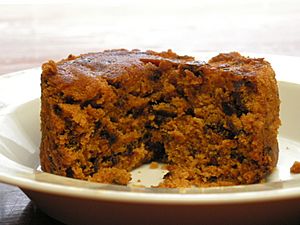Spotted dick facts for kids

Spotted dick
|
|
| Type | Pudding |
|---|---|
| Place of origin | United Kingdom |
| Main ingredients | Suet, dried fruit, flour, sugar, milk, baking powder |
Spotted dick is a classic British baked pudding. It is also sometimes called "spotted dog" or "railway cake." This tasty dessert is traditionally made with suet (a type of fat), dried fruit like currants or raisins, and flour. People often serve it warm with creamy custard.
Some modern versions of spotted dick might use different fats, like butter, instead of suet. Other recipes might add eggs, making the pudding more like a soft sponge cake.
What's in a Name?
The name "spotted dick" might sound a bit unusual, but it's easy to understand! The word "spotted" simply describes the dried fruit in the pudding. These fruits look like little spots spread throughout the dessert.
The word "dick" is an old, old term. It was once a common way to say "pudding" or "dough" in some parts of Britain. So, if you were to use modern words, the name would mean "spotted pudding."
A Look Back in Time
The first known recipe for this pudding appeared in a cookbook in 1849. It was written by a famous chef named Alexis Soyer. He called his recipe "Plum Bolster, or Spotted Dick."
The name "spotted dog" was first seen a few years later, in 1855. This name, along with "railway cake," is quite popular in Ireland. In Ireland, the pudding is often made more like a soda bread loaf with currants.
In 1892, a newspaper called the Pall Mall Gazette reported that a group called the "Kilburn Sisters" served "Spotted Dick" to many dock workers every day.
Over the years, the name of this pudding has sometimes caused giggles. Because of this, staff in the Palace of Westminster (where the British Parliament meets) decided to rename it "Spotted Richard." They did this so the name would be less likely to cause a stir or jokes.
See also
 In Spanish: Spotted dick para niños
In Spanish: Spotted dick para niños


